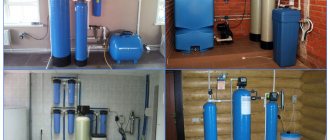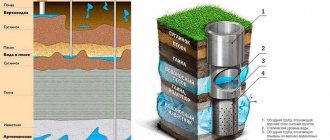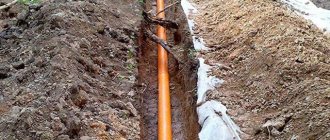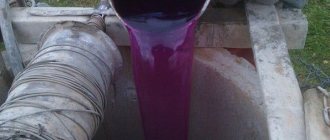How are aquifers located in the ground?
To understand how to find water in a well site, you need to know the basic principles of the location of underground sources. In the thickness of the earth there are waterproof layers that retain water. Thanks to them, the veins cannot sink lower or rise to the surface. The main components of such layers are clay and stones, substances that do not absorb or allow moisture to pass through.
The space between the clay layers, containing clean water, is filled with a sand layer. This layer constitutes the aquifer, which must be reached when digging a well. Moreover, the sand cushion is unevenly located: in some places it is thin, and in others it can reach 10 m. The vein line often breaks and the largest amount of water collects in such places.
There are also places with a curved shape of the clay layer. Here a kind of bowl is formed into which water flows. There is so much of it that these places are often called underground lakes.
Diagram of the location of groundwater in the soil Source ms.decorexpro.com
In order to determine the approximate depth of the aquifer, you can use a special map of the area. However, the information in it can be found very approximate. The exact location can only be determined if you dig a well hole.
Those who are wondering how to find water in a well site themselves should take note that the upper part of the aquifer is already located at a depth of 1.5-2 m. But this will be too polluted water, because due to the proximity of the surface, sewage and untreated atmospheric precipitation. Such sources are suitable only for irrigation and domestic needs.
This layer is popularly called “upper water”. He is extremely unstable. Often during droughts or cold weather, water leaves it. During spring floods, it can flood nearby areas.
It is believed that drinkable water can already be found at a depth of about 15 m, although in practice it is often necessary to dig up to 25-30 m. There is a layer of continental sands that contains pure moisture. At the same time, a fifteen-meter layer of soil ensures complete purification of water from all components that pollute it.
A sufficiently deep well on the site can become a supplier of drinking water Source za.pinterest.com
How does water quality depend on the depth of the aquifer?
In the location of aquifers, it is believed that water quality improves as depth increases. This is actually true. During the private construction of wells or boreholes, the first water begins to appear already at a depth of 2-3 meters from the surface. This is the water of the first aquifer. It is contaminated with chemicals and organic matter that comes from the surface. Wastewater, which easily penetrates into the first aquifer, is of great importance. When constructing a well, the optimal digging depth is 15-20 meters.
Groundwater and interstratal waters lie here. To find an artesian vein, you need to dig further. In this case, it is better to use drilling. Thus, the occurrence of aquifers is of great importance for the water supply of the population. Many regions experience a shortage of clean water, which is the reason for searching for new sources.
Where can you dig wells?
Before looking for water for a well on the site, you need to decide on the places in which the structure can be installed. We recommend that you familiarize yourself with the general rules for the location of wells in order to organize safe and convenient water extraction.
The drinking source must be located at least 25 meters from the epicenters of soil pollution, such as cesspools, landfills, sewers, and street toilets. Otherwise, harmful substances and pathogenic bacteria may enter the well through the water-containing layers.
General diagram of a site with a well for drinking water Source syko.ru
The well should be moved 10-15 m away from the buildings to protect the buildings from flooding. At the same time, you also need to pay attention to the objects of the neighboring area.
However, a standard summer cottage plot is 4 acres. At the same time, it is always densely planted and built up and there is a problem with compliance with standards. In this case, you can move it to a distance of only 5-7 m from the house or outbuilding.
These rules apply to shaft-type wells. Deep wells require an even greater distance from buildings and contaminated areas.
Those who are interested in how to find a place for a drinking well should remember that it is better to avoid:
- places subject to frequent flooding;
- wetlands;
- areas adjacent to highways.
Using this principle, you can place wells of varying depths Source domotheme.ru
See also: Catalog of house projects for permanent residence
If the soil in the area of the planned well is clayey, then the risk of flooding of the site is noticeably reduced. But at the same time it is necessary to organize careful insulation of the walls of the structure. You can dig special frame rings made of asbestos into the ground. This will protect the water from contamination associated with melting snow and precipitation.
How to find water on the site: working methods
Below we will describe various methods for finding water for a well. All of them have a scientific basis and have proven themselves well. Therefore, we advise you to pay attention to the following points:
- Fog. To use this method, you need to get up early in the morning and inspect the area. In some places there will be a slight, barely noticeable haze above the ground - something like fog. This indicates the location of aquifers close to the surface. At the same time, you need to understand that if the cause of the fog is moisture escaping from the soil, then it will rise in clouds upward and then settle near the ground.
- Behavior of insects and animals. This method requires maximum observation. For example, horses, when looking for water, begin to hit a place with high humidity with their hoofs. Dogs in hot weather reduce their body temperature by digging holes in wet soil and lowering their heads into them. In the evening, mosquitoes swarm where there is more evaporation from the ground. Mouse holes are never found in places with shallow water-bearing veins. At the same time, ducks, geese and swans always lay eggs above underground springs.
Strange behavior of animals may indicate the presence of underground sources Source m.yukle.mobi
- Plants. Places with shallow water carriers can be found by the presence of some representatives of the flora. Thus, the proximity of the vein is evidenced by the lush growth of coltsfoot, sorrel, and hemlock. Nettle always grows in fairly moist soil. In the driest places, moisture-loving plants are not found. Pines are always found where the water is quite deep.
- Glass jars. For such an experiment, you need to place glass jars around the entire area in the evening, neck down, and leave them until the morning. In the morning, the dishes located closest to the aquifer will have more condensation than others.
Video description
Here is a video describing this method of finding water:
- Brick and salt. The method is based on the fact that these substances absorb moisture well. However, the soil must be completely dry. Here's how to determine where to dig a well on a site: pour salt or crushed brick into a clay pot, weigh it and record the mass. Then the vessel is wrapped in gauze and buried half a meter into the ground. A day later, the pot is dug up and weighed. Too large an increase in mass indicates the proximity of an aquifer.
Using table salt you can search for aquifer veins Source sakadangkuya.com
- Barometer. If there is a body of water near the site, you can use a classic aneroid. The fact is that the pressure increases by 1 mm. Hg Art. when lowered every 13 m. The aquifer will lie at approximately the same level as the natural well. And in order to determine the approximate depth of an underground source, you need to measure the pressure on the shore of the reservoir and at the site of the proposed digging, and then, based on the difference in readings, calculate the height difference.
- Wells in neighboring areas. If a neighbor has built a working well or well near the border of their yards, then there should be water on your property. You can ask how deep the mine is and what kind of rocks are encountered along the way. This way you can collect the necessary hydrological data and plan your work.
You can contact your neighbors for the necessary information Source m.fishki.net
But the most accurate and reliable way to find water on a site for a well with your own hands is exploratory drilling. It is advisable to choose a place to work based on all the methods described above. It is necessary to drill a small diameter well with a depth of 7-8 m. For this, you can use the most ordinary drill. If an aquifer is discovered, you can start digging a well.
Types of wells
Everything is clear with aquifers. Now you need to understand the types of well drilling.
Abyssinian well
It is also called Norton's well, because the technology for drilling this well for water was invented by the British engineer Norton. This type of well is not drilled; it uses the method of driving casing pipes into the ground, so a sharp tip is installed at the end of the first pipe. A little higher in the pipe itself, small holes are made through which water will flow into the casing. They will also act as a filter.
Casing pipe for Abyssinian well
It will not be possible to drive pipes deep, especially into the ground where there are a lot of stones. Therefore, the drilling depth is maximum 12 m.
Sandy
A full-fledged well, which will provide a large volume of water for a country house, must reach loose rock (sand, pebbles or a mixture of both). Therefore, the technology for drilling a sand well for water can be done either manually using a drill, or using a small automatic drilling rig. You can, of course, accept the services of a self-propelled installation, which is located on a vehicle chassis. But such a service is not cheap.
Taken together with the price of all the elements of the water supply system that may be needed (pumping equipment, pipes and hoses, a caisson to protect the pump and well if a surface option is chosen, a hydraulic accumulator, etc.), the total cost of the well can turn out to be quite impressive. Therefore, most often they stop at using a small drilling rig or the manual method. In terms of time, drilling such a well is quite fast - the aquifer is reached in 2-3 days. After this, the sediment is installed, the water supply elements and water can be used.
Small drilling rig
It should be noted that a sand well will last 10-30 years, depending on the volume of water in the formation. When constructing it, steel or plastic sediment is used. Plastic pipe has come into use recently. It does not rust, its price is several times less than steel. But it has a low strength resource. If the well passes through quicksand, the latter easily squeeze it.
Artesian
Such wells are also called lime wells. In principle, they have one distinguishing feature from sand ones - the absence of a filter at the end of the pipe. Because the water in the lower aquifers is clean with a minimum amount of impurities.
Limestone wells have a large water resource, so their service life is 50 years. Its flow rate is at least 10 m³/h. If we compare this indicator with the sand variety, then for the latter it is 3 m³/h. And this is the maximum figure.
Drilling an artesian well
Of course, anyone who wants to get the purest water for their own consumption for many years to come gives their preference to an artesian well. True, such a structure costs a lot of money, so usually neighbors unite and drill it into several houses.
Searching for water using a wire or vine
The use of aluminum wire and wicker is another well-proven technique. Frames have been used to find water since ancient times. The operating principle of such devices is based on the phenomenon of dowsing and the properties of the magnetic field.
This is how you can find water in your area Source ms.decorexpro.com
Video description
We recommend watching this video describing the use of an aluminum frame for searching for water:
Now let's talk about how to look for water for a well using a vine. As an indicator, you can use a section of a branch of any tree with a fork, the angle of which is approximately 150°. The branch is thoroughly dried in the sun, and then taken by hand by the two ends so that the central main part is directed forward. Then with such a “device” they walk around the site. Close occurrence of aquifers is possible in those places where the trunk tilts towards the ground.
Dowsing gives the most accurate readings at certain time intervals:
- from 6 to 7 am;
- from 16 to 17 hours;
- from 20 to 21 o'clock;
- from midnight to one in the morning.
Few people know how to correctly determine the location of an underground source using a vine. Source bastanshenas.com
Although the vine and aluminum provide fairly accurate information about the presence of water, the source may turn out to be just perched water. Therefore, in any case, immediately after discovering areas with high humidity, exploratory drilling should be carried out.
How to find out the depth of an already drilled well
Once a well has been drilled, it is sometimes necessary to determine its depth. For this purpose, you can use special tools, such as:
- Hydrogeological roulette. She measures depths up to fifty meters. If this is not available, you can use a weighted cord. You can use a brick or some metal object as a weighting agent.
- Special logging cable. This tool has a measuring roller, one unwinding of which is equal to one meter.
- Depth gauge. This device allows you to measure the angle and depth of a well through an echo signal that is sent and then reflected from its bottom.
To provide a plot of land with water by drilling a well, you must be able to correctly determine the location of groundwater, as well as its depth. This can be done with the help of special maps and tools, as well as with the help of folk signs.
Briefly about the main thing
Water is located underground between layers of water-resistant substances. Most often, these substances are clay and stones.
Water in underground springs is contained in a layer of sand, which has different thicknesses in different places.
Water accumulates in large quantities where the waterproof layer forms a kind of bowl.
Wells must be built away from landfills, sewers, roads and at a distance from buildings.
To find water in an area, you can watch the evaporation of the earth or the behavior of animals and insects.
To search for water in the area, you can use salt, glass jars, a barometer, aluminum wire or a vine.
It is better to carry out exploratory drilling in the places where the aquifer vein is supposed to occur.
Ratings 0
Where does groundwater accumulate?
Before you start looking, it's worth learning a little more about groundwater. Moisture underground accumulates inside the so-called aquifers as a result of filtration of atmospheric precipitation. Liquid, sandwiched between waterproof soil layers consisting of stone or clay, forms reservoirs of various sizes.
Their location is not strictly horizontal; they can bend, forming in such areas peculiar lenses filled with water. Their volumes are also very diverse: from several cubic meters to tens of cubic kilometers.
A diagram of the occurrence of groundwater is necessary to have at least some idea of where the source may be
Closest to the surface, at a depth of only 2-5 m, lies the “overwater”. These are small bodies of water fed by precipitation and melt water. In dry times, they usually dry out and cannot be a source of water supply. In addition, water from them can most often be used only for technical purposes. Of greatest interest to humans are deep aquifers containing large reserves of perfectly filtered water. They usually lie at a depth of 8-10 meters and below. The most valuable water, enriched with minerals and salts, is located even deeper, at a distance of about 30-50 m. Getting to it is possible, but difficult.










